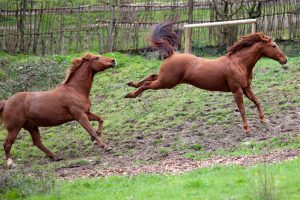Difficult horses – prevalence, approaches to management of and understanding of how they develop by equine veterinarians
Difficult horses – prevalence, approaches to management of and understanding of how they develop by equine veterinarians

our summary:
Pearson, G. et al (2021) Difficult horses – prevalence, approaches to management of and understanding of how they develop by equine veterinarian. Equine Veterinary Education, 33 (10) pp 522-530.
The aim of this survey-based study was to document the experiences faced by equine veterinarians when working with difficult horses and to develop a greater understanding of the most common types of unwanted behaviours, methods of dealing with these and knowledge of the processes by which horses learn.
The online questionnaire was publicised twice in the British Equine Veterinary Association (BEVA) e-newsletter and a link to the questionnaire was sent by email to the referring practices of the authors’ institutions.
A total of 220 questionnaires were completed, of which 168 were included in the final analysis. One-hundred-and-twenty-three (73%) respondents reported spending all their working time with horses, and 132 (79%) saw more than 50 horses a month.
Ninety-five percent of respondents reported that they had interactions with horses that they felt to be difficult at least a few times each month. The most common unwanted behaviours were horses being bargy/pushy, unwilling to stand still and were needle or head shy. These behaviours were reported significantly less frequently with increasing length of time working in equine practice.
One-hundred-and-thirty-six (81%) respondents reported that they had sustained at least one injury caused by the horse they were treating or examining in the previous five years. In total, 579 injuries were reported of which 88 (15%) required a hospital visit and 61 (11%) a GP visit. Ninety-two (16%) injuries led to time off work and 215 (37%) injuries resulted in continued discomfort or loss of function. 92% of respondents reported that they were in a potentially dangerous situation on at least a monthly basis.
The most commonly used method of restraint was chemical sedation, followed by nose or neck twitch. Sixty-five (46%) respondents reported that they had received no training on equine learning theory, however, 131 (78%) reported that they understood how horses learn and were able to apply this knowledge at least moderately well.
However, when tested on their understanding of learning theory terminology, of the 141 respondents who stated they understood the term positive reinforcement, only 22 answered correctly, and of the 134 who started they understood the term negative reinforcement, only 37 were correct.
Limitations of the study include the low response rate, potential selection bias and that the respondents may not be representative of equine veterinary surgeons in the UK; the authors note that the study population was overrepresented by vets from Scotland because of their association with the authors’ institutions.
This survey study provides some evidence of the frequency with which equine vets work with horses that they perceive to be difficult, and the concerning number of injuries that equine vets sustain. The survey results suggests that knowledge of horse learning theory is still low and that educating vets on equine learning theory may help to reduce the high prevalence of occupational injuries within the equine veterinary profession.
Image copyright attribute: anjajuli
Join the discussion
We encourage discussion on all material highlighted in each edition of inFOCUS. Use the button below to join the conversation on Twitter and include your comment in the feed for this issue.





Leave a Reply
Want to join the discussion?Feel free to contribute!